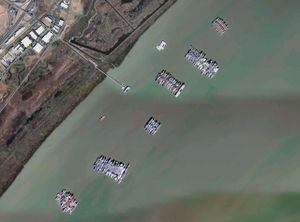Suisun Bay Reserve Fleet

The Suisun Bay Reserve Fleet is located on the northwest side of Suisun Bay (the northern portion of the greater San Francisco Bay estuary) in Benicia, California. The fleet is within a regulated navigation area that is about 4 ½ miles (7.2 km) long and ½ mile (0.80 km) wide. It begins just north of the Union Pacific Railroad Bridge and runs northeast, parallel to the shoreline. Water depths range from about 46 feet (14 m) at Mean Lower Low Water (MLLW) at the foot of the anchorage, to about 26 feet (8 m) MLLW at the shallowest berths towards the northern end of the anchorage. In 2022 about eight ships remain in the fleet.
Purpose
The U.S. Maritime Administration (MARAD) maintains the National Defense Reserve Fleet, a fleet of vessels that serves as a reserve of ships for national defense and national emergency purposes. The reserve fleet program began in 1946 at the end of World War II. At its peak in 1950, the program had more than 2,000 ships in lay-up. One of the reserve fleet storage sites is in Suisun Bay, the northern portion of San Francisco Bay. Only a small portion of vessels currently remain with the Suisun Bay Reserve Fleet. In January 2016, the Department of Transportation and MARAD officially announced the fleet closure in February 2017. All remaining ships will be sold at auction or scrapped. The other two active fleets are James River Reserve Fleet and Beaumont Reserve Fleet.
Environmental issues
The State of California and several environmental groups have raised concerns about the environmental impacts of the fleet. Potential concerns include heavy metals and anti-fouling agents in the paint that is peeling off of the vessels, as well as PCBs and other hazardous materials that may have been released. Congress responded to these concerns by funding the National Oceanic and Atmospheric Administration (NOAA) to design and implement a study of contaminants in the vicinity of the fleet.
NOAA's Damage Assessment, Response and Restoration Program (DARRP) began work on this project in January 2008. Since then, NOAA's team has assessed existing data from the area to determine data gaps, researched the history and environmental setting of the site, discussed the project with numerous stakeholders, conducted a site visit, and developed and refined a sampling and analysis plan. NOAA deployed bivalve samples in June 2008 and collected sediment and bivalve tissue samples from the area in July 2008. A second field sampling event for additional tissue samples occurred in September. These samples were analyzed and a data report was delivered in early 2009.
Based on these findings, the United States Government has reached an agreement with Arc Ecology, San Francisco BayKeeper, Natural Resources Defense Council, and the California Regional Water Quality Control Board, San Francisco Bay Region (Regional Board) regarding the maintenance and disposal of obsolete ships owned by the U.S. Department of Transportation's Maritime Administration (MARAD) at the Suisun Bay Reserve Fleet site, resolving a lawsuit in the Eastern District of California. Under the agreement, MARAD will clean, maintain, and dispose of these ships in a manner that eliminates sources of Bay pollution. The Maritime Administration has already begun removing obsolete ships from Suisun Bay for recycling. Several ships have left since November 2009. Eight ships remain.
Under the terms of the settlement:
- Hazardous paint debris collected on vessel decks will be removed within 120 days.
- All the obsolete ships currently located at the site will be cleaned of flaking paint within two years.
- Twenty-eight ships in the worst condition will be removed for disposal by 30 September 2012.
- Before their removal, these ships will be sent to a local drydock for cleaning (removing marine growth from the underwater hull and removing flaking paint from areas above the water).
- All the obsolete ships currently located at the site will be removed for disposal by 30 September 2017.
- Prior to removal, the ships will be maintained according to locally approved best management practices, as monitored by the Regional Board.
- The horizontal surfaces of the obsolete ships will be cleaned every 90 days to prevent peeling paint from getting into the water; monthly and quarterly inspections will be conducted; and water runoff samples will be collected regularly.
- No new ships with excess flaking paint will be admitted to the fleet site.
Notable ships
- USS Mount Hood (AE-29) - sold for scrap in 2013
- USS Pyro (AE-24)
- USS Tulare (LKA-112)
- USS Bolster (ARS-38)
- USS Clamp (ARS-33)
- USS Pigeon (ASR-21)
- USS Point Defiance (LSD-31)
- USS Sperry (AS-12)
- USS Thomaston (LSD-28)
- USS Vancouver (LPD-2)
- USCGC Glacier (WAGB-4)
- USS Holland (AS-32)
- USS Nereus (AS-17)
- USS Reclaimer (ARS-42)
- USNS Wyman (T-AGS-34)
- USNS Comet (T-AKR-7)
- USNS Meteor (T-AKR-9)
- USS Cimarron (AO-177)
- USNS Hassayampa (T-AO-145)
- USS Kansas City (AOR-3)
- USNS Kawishiwi (T-AO-146)
- USNS Mispillion (T-AO-105)
- USNS Ponchatoula (T-AO-148)
- USS Roanoke (AOR-7)
- USNS Shoshone (T-AO-151)
- USS Wabash (AOR-5)
- USS Wichita (AOR-1)
- USS Willamette (AO-180)
- USS Hoga (YTM-146) –
- moved to Arkansas Inland Maritime Museum as a museum ship
- USS Iowa (BB-61) –
- moved to the port of Los Angeles as a museum ship
- Sea Shadow (IX-529)
- USCGC Storis (WMEC-38)
- USCGC Iris (WLB 395)
- Glomar Explorer, also known as USNS Hughes Glomar Explorer (T-AG-193), and later GSF Explorer
Note
A very good image of the Suisun Bay Reserve Fleet is shown in the 1975 version of the movie, The Killer Elite with James Caan.
Chat rooms • What links here • Copyright info • Contact information • Category:Root